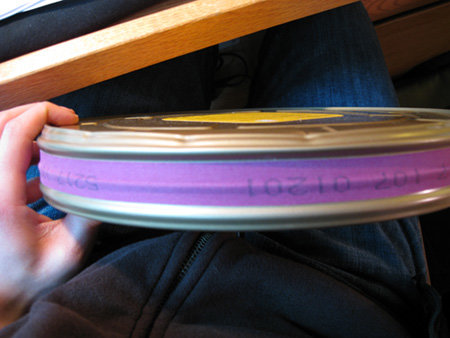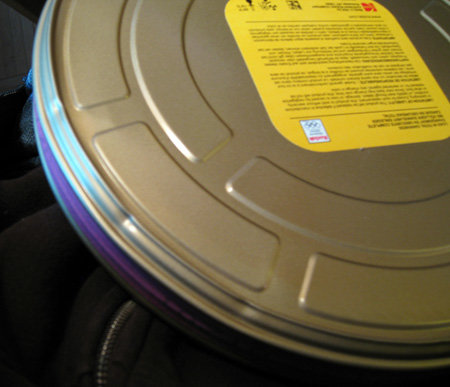
Wai Choy
Basic Member-
Posts
29 -
Joined
-
Last visited
Profile Information
-
Occupation
Student
-
So I'm shooting my Super 35mm film this weekend starting on Saturday and I just found out today that the two of the four S4 Primes I reserved were stolen. I had reserved a 25mm, 32mm, 50mm, and 100mm. The 25 and 50 got stolen. The only other S4s that the rental house has are the 14mm (not appropriate at all for my film) and the 40mm (which leaves a huge gap between 32mm and 100mm). They do have some Arri Ultra Primes available though that would fill those gaps. Is it possible to shoot with both Arri Ultra Primes and S4 Primes or would that be visual suicide? What are the differences in terms of "look" between the two types of lenses? I may have to make do with less than ideal selections from either the Arri or Cooke sets. Please let me know ASAP. Thanks a lot! Wai
-
I recently got six 1000' rolls of Vision2 200T 5217 donated by Kodak that has minor dents on the outer rim. They have been in my fridge ever since. I've noticed that there has been a bit of freezing of water inside the fridge, so I'm guessing that somehow the temperature has dipped below 32 degrees F and 0 degrees Celcius. I don't know what the humidity level of the fridge is. My shoot will be in 2 months and I will be purchasing 9 more 1000' rolls of the same stock, new from Kodak. Should the footage shot on the film in my fridge and the new film I buy look the same? Also, how can I tell if the film in my fridge is okay? Thanks.
-
Hi, On my thesis film we'll have various practical lights in the interior sets, which we're building on a soundstage. We'll be shooting on Vision2 200T 5217, so I assume that the practical lights will need to output a significant amount of foot candles so that the lampshades, etc. will appear to be illuminated from within by the practical light bulbs even though we'll obviously be supplementing the lights with off-camera lights. My art director and I are buying lamps from consumer places like Bed, Bath, & Beyond, and many of the lights specify "40 watt bulb," "60 watt bulb," etc, which seem to be very low wattages. What can we do to get the most light output from each of our lamps? Is there a way to use higher wattage bulbs in the lamps than specified? Are there certain kinds of lightbulbs that would have a higher light output? Thanks in advance for your help!
-
Cool thanks for the clarification. Is there a way to tell how old the film is by looking at the code numbers on the canisters? The rolls are from 3 different emulsion numbers so I assume that they were made at different times. Should I bother having them tested? I assume they've been stored properly, since I picked them up from the Kodak New York Warehouse
-
Hahah yeah I wondered about that but just asked to be sure. I thought maybe it would have something to do with the silver halides shifting from the impact.......or something like that.......... So As long as I spool off the film that's under the crushed area, the rest should be good to shoot for sure? Any other potential concerns?
-
By the way, when I shake the canister I can definitely feel and hear the film move, but I can also feel some resistance in the area where the canister was crushed.
-
-
To what extent is that true? Should I not shoot with these rolls then? I don't want to take a risk on having my shots messed up if that's a danger. I've attached photos of the dents on the cans. They all have dents only on one part of the canister and they're all about the same. They came in a single box, so I assume that they were all crushed from the top down, which is why the dents look similar. I know it's a little hard to see, but can you please take a look and let me know the extent of the damage? There are no dents other than the outside rim area of the canister. The rim has been crushed in a little bit and the canister top has been pushed in a bit near the rim. THE GOOD NEWS: Even if the crushing destroyed the film, it would only have destroyed about 100-200 feet maximum of film. SO, MY MAIN CONCERN IS: Is the film grain or anything else potentially compromised by the crushing, dropping, or whatever it was that caused the dents? Please let me know. Thanks! Wai
-
Thank you everyone for your help. Here's an update: I picked up 6 rolls today and thankfully there are barely any dents on the canisters, and the ones that there are are very minor. I have one last question. What do emulsion numbers mean? They are all Kodak Vision2 5217 but some of the rolls are different emulsion numbers. I have: Emulsion number 106, 107, and 128. Can you please tell me what this means? Does this mean that the film is different in any way? Thanks again. Wai
-
Thanks for the response. Can you feel with your fingers on the film if it has been damaged? Like when you have the roll in the changing tent, can you feel bends/dents in the film? I would hope that you could just keep spooling off film until it doesn't feel damaged anymore. Is that possible? And I'm assuming that if the dents are on the surface of the can and not the rim, then the film is pretty much worthless. Am I right? I'll be picking up the film cans tomorrow. I guess the only way to know if the dents are bad or not (since I have no frame of reference) would be to upload pictures of the cans and get your opinion on it, since you seem to be quite familiar with this scenario. I'll post the pics ASAP tomorrow and would appreciate it if you'd let me know what you think. Thanks again!
-
I was lucky enough to get six 1000' rolls of 35mm Kodak Vision2 donated by Eastman Kodak, but the catch is that the cans are dented. My contact person said that this should not be a problem, but I don't want to take a risk if there is one. Should the film in the cans be okay? They're completely new except they have dents in them. Thanks! Wai
-
I know all about ND filters, conversion filters, color filters, etc. However, what I do not know about are filters for 35mm film lenses that modify the look of the image. I've heard about Promist, LowCon, UltraCon, etc. filters but have no idea what they're used for or what the images shot with them would look like. Would you please fill me in on the main look-modifying filters and what their effects are? Thanks a lot. Wai
-
Hi, I'm prepping to shoot my thesis film in May, 2008 and am talking to a couple of rental houses in New York regarding renting a 35mm package. The two cameras that I'm looking at renting are either the Aaton 35-III or the Moviecam Compact MKII. My needs for the shoot are: - Camera must be quiet enough to not be picked up by the microphone even when the camera is close to the mic. - Camera must be able to shoot 3-perf super 35mm without jamming or other issues. - Camera must be light, compact, and easy to fly on a steadicam rig. Which camera would you say is better and what pros and cons are there for each camera? I haven't used either of these cameras before, so it would be really helpful if you'd fill me in on any weaknesses or glitches that these cameras have. Thanks a lot for your help! Wai



